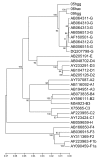Hepatitis B virus genotypes and resistance mutations in patients under long term lamivudine therapy: characterization of genotype G in Brazil
- PMID: 18211717
- PMCID: PMC2245951
- DOI: 10.1186/1471-2180-8-11
Hepatitis B virus genotypes and resistance mutations in patients under long term lamivudine therapy: characterization of genotype G in Brazil
Abstract
Background: Lamivudine is an oral nucleoside analogue widely used for the treatment of chronic hepatitis B. The main limitation of lamivudine use is the selection of resistant mutations that increases with time of utilization. Hepatitis B virus (HBV) isolates have been classified into eight genotypes (A to H) with distinct geographical distributions. HBV genotypes may also influence pathogenic properties and therapeutic features. Here, we analyzed the HBV genotype distribution and the nature and frequency of lamivudine resistant mutations among 36 patients submitted to lamivudine treatment for 12 to 84 months.
Results: Half of the patients were homosexual men. Only 4/36 (11%) patients were HBV DNA negative. As expected for a Brazilian group, genotypes A (24/32 positive individuals, 75%), D (3/32, 9.3%) and F (1/32, 3%) were present. One sample was from genotype C, which is a genotype rarely found in Brazil. Three samples were from genotype G, which had not been previously detected in Brazil. Lamivudine resistance mutations were identified in 20/32 (62%) HBV DNA positive samples. Mean HBV loads of patients with and without lamivudine resistance mutations were not very different (2.7 x 107 and 6.9 x 107 copies/mL, respectively). Fifteen patients showed the L180M/M204V lamivudine resistant double mutation. The triple mutant rt173V/180M/204V, which acts as a vaccine escape mutant, was found in two individuals. The three isolates of genotype G were entirely sequenced. All three showed the double mutation L180M/M204V and displayed a large genetic divergence when compared with other full-length genotype G isolates.
Conclusion: A high (55%) proportion of patients submitted to long term lamivudine therapy displayed resistant mutations, with elevated viral load. The potential of transmission of such HBV mutants should be monitored. The identification of genotypes C and G, rarely detected in South America, seems to indicate a genotype distribution different to that observed in non treated patients. Disparities in routes of transmission (genotype G seems to be linked to homosexual behavior) and in pathogenic properties (genotype C is very aggressive) among HBV genotypes may explain the presence of rare genotypes in the present work.
Figures


Similar articles
-
Hepatitis B virus genotypes and lamivudine resistance mutations in HIV/hepatitis B virus-coinfected patients.J Acquir Immune Defic Syndr. 2007 Apr 15;44(5):557-61. doi: 10.1097/QAI.0b013e3180314b46. J Acquir Immune Defic Syndr. 2007. PMID: 17224847
-
[Determination of hepatitis B virus genotype and detection of lamivudine-resistance mutations].Gastroenterol Hepatol. 2004 Nov;27(9):515-20. doi: 10.1016/s0210-5705(03)70518-4. Gastroenterol Hepatol. 2004. PMID: 15544736 Spanish.
-
The clinical impact of early detection of the YMDD mutant on the outcomes of long-term lamivudine therapy in patients with chronic hepatitis B.Antivir Ther. 2006;11(4):447-55. Antivir Ther. 2006. PMID: 16856618 Clinical Trial.
-
Hepatitis B virus genetic multiplicity and the associated HBV lamivudine resistance mutations in HBV/HIV co-infection in Western Kenya: A review article.Infect Genet Evol. 2022 Mar;98:105197. doi: 10.1016/j.meegid.2021.105197. Epub 2021 Dec 24. Infect Genet Evol. 2022. PMID: 34954390 Review.
-
Naturally occurring hepatitis B virus reverse transcriptase mutations related to potential antiviral drug resistance and liver disease progression.World J Gastroenterol. 2018 Apr 28;24(16):1708-1724. doi: 10.3748/wjg.v24.i16.1708. World J Gastroenterol. 2018. PMID: 29713126 Free PMC article. Review.
Cited by
-
HBV endemicity in Mexico is associated with HBV genotypes H and G.World J Gastroenterol. 2013 Sep 7;19(33):5446-53. doi: 10.3748/wjg.v19.i33.5446. World J Gastroenterol. 2013. PMID: 24023487 Free PMC article. Review.
-
Phylogenetic analysis and genotype distribution of Hepatitis B Virus (HBV) in Roraima, Brazil.Rev Inst Med Trop Sao Paulo. 2018 Jul 19;60:e35. doi: 10.1590/S1678-9946201860035. Rev Inst Med Trop Sao Paulo. 2018. PMID: 30043939 Free PMC article.
-
An in-house real-time polymerase chain reaction: standardisation and comparison with the Cobas Amplicor HBV monitor and Cobas AmpliPrep/Cobas TaqMan HBV tests for the quantification of hepatitis B virus DNA.Mem Inst Oswaldo Cruz. 2016 Feb;111(2):134-40. doi: 10.1590/0074-02760150415. Mem Inst Oswaldo Cruz. 2016. PMID: 26872342 Free PMC article.
-
Identification of Novel Recombinant Forms of Hepatitis B Virus Generated from Genotypes Ae and G in HIV-1-Positive Japanese Men Who Have Sex with Men.AIDS Res Hum Retroviruses. 2015 Jul;31(7):760-7. doi: 10.1089/AID.2014.0281. Epub 2015 May 4. AIDS Res Hum Retroviruses. 2015. PMID: 25825936 Free PMC article.
-
Prevalence and epidemiological traits of HIV infections in populations with high-risk behaviours as revealed by genetic analysis of HBV.Epidemiol Infect. 2013 Nov;141(11):2410-7. doi: 10.1017/S0950268812003123. Epub 2013 Jan 25. Epidemiol Infect. 2013. PMID: 23347648 Free PMC article.
References
-
- Arauz-Ruiz P, Norder H, Robertson BH, Magnius LO. Genotype H: a new Amerindian genotype of hepatitis B virus revealed in Central America. J Gen Virol. 2002;83:2059–2073. - PubMed
-
- Stuyver L, De Gendt S, Van Geyt C, Zoulim F, Fried M, Schinazi RF, Rossau R. A new genotype of hepatitis B virus: complete genome and phylogenetic relatedness. J Gen Virol. 2000;81:67–74. - PubMed
Publication types
MeSH terms
Substances
Associated data
- Actions
- Actions
LinkOut - more resources
Full Text Sources
Research Materials

